Eco-Tourism in the Ogasawara Islands: Composting toilet Lessens Inbound Impact
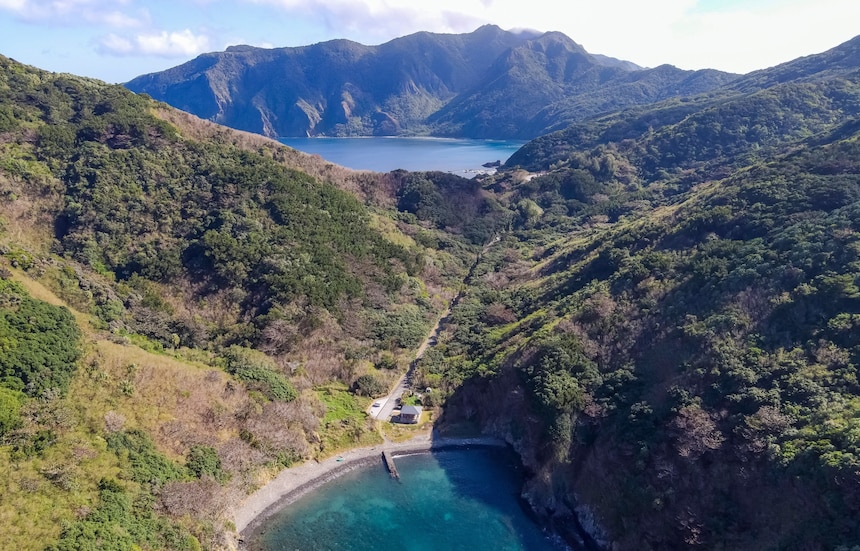
Protecting the natural habitat of a remote Japanese island chain requires dedication, perseverance, and a commitment to controlled development. Joy Jarman Walsh traveled to Hahajima and talked to islanders about preserving the ecosystem, and the latest introduction of sustainable technology—a composting toilet to lessen the impact of visitors.
The Ogasawara Islands are a chain of islands some 1000 kilometers south of Tokyo that can only be reached by a 24-hour ship ride. They have been listed on UNESCO’s Natural World Heritage List for the wealth of their ecosystems which host many rare and endemic species. Hahajima (Mother Island) is one of the two inhabited islands, and retaining its unspoiled nature is the cause of conservation activities aimed at protecting its unique ecosystem. One recent initiative was the installation of a composting toilet, a sustainable waste management system that signals the island’s commitment to sustainability and conservation. On a trip to this fascinating island, we spoke to a number of people about the impact of this project and the state of the island’s natural habitat.
【Islander①】Expectations for composting toilet to realize symbiotic coexistence between people and nature / Kenichi Hayashi (Chairman, Hahajima Tourism Association)
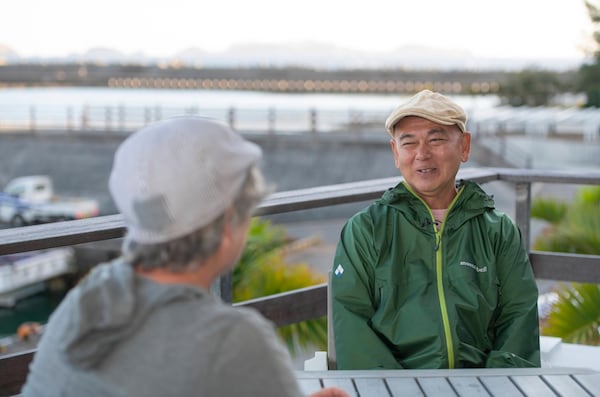
Kenichi Hayashi is the chairman of the Hahajima tourism Association, which must find ways to balance the needs of some 3,000 annual visitors with those of about 450 residents. That includes mitigating the strain on local water resources and waste management. One important step was the recent installment of a composting toilet that is self-sufficient, and off the power, water, and sewage grid. It is located at Kitakou a popular sightseeing and leisure spot. “composting toilet not only reduce demand for water and energy on the island, but are reliable during natural disasters, when power or water may cut out,” says Hayashi.
There are countless benefits from composting toilets. They are more hygenic, less damaging to the environment, and require less labor to maintain. The operation is simple, yet effective, an eco-friendly design that doesn’t use water or electricity. After use, a motor powered by a nearby solar panel agitates the waste and covers it with sawdust. After a period of time, the completed compost can be used as fertilizer. The operation is equally sustainable, requiring only weekly maintenance for cleaning and replacing the toilet paper, and twice-a-year maintenance for checking the motor and replacing the sawdust.
The toilet is part of environmentally friendly efforts stretching across the Ogasawara islands, and Hayashi believes it is also visually important. “Even islanders are not aware of some of our activities,” says Hayashi. “These toilets are a visual reminder of environmental considerations, and can help change peoples’ awareness of nature.” He believes that another positive factor is the toilet as a talking point. “I think guides will use it to talk about our impact on the natural environment,” he says.
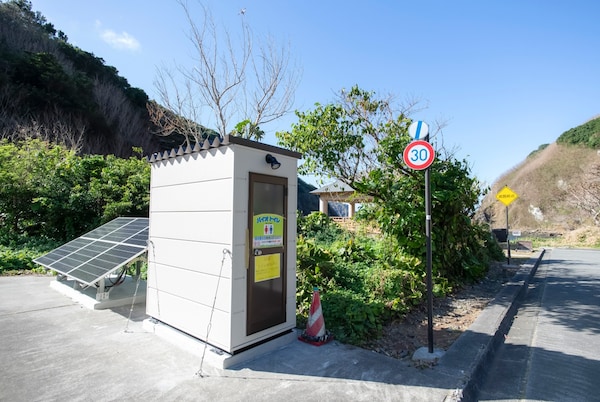
Composting-toilet built in North Port. It is powered by sawdust and solar power and requires no water.

The North Port is a historical area on Hahajima that once hosted a prosperous settlement in the era prior to World War II. It still retains much of its heritage and is popular among locals and tourists alike.
【 Islander②】Walking with Green sea turtle, Jewels of the Sea Eco-tour guide leading environmental protection on Hahajima, Ogasawara / Koya Kawabata (Hahajima Nature Tour Guide Mommy Shark Co.)
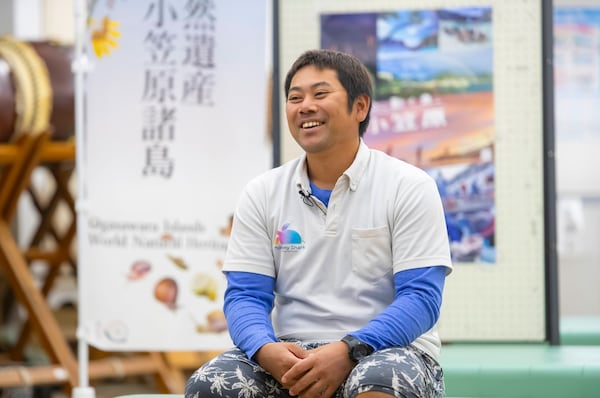
Koya Kawabata’s love affair with Hahajima started soon after visiting as a green sea turtle researcher 11 years ago. He chose to make Hahajima his home, where his company organizes eco-tours. He often talks with organizations and businesses about nature preservation strategies he has been researching. Kawabata says he has been warmly welcomed as a member of the small community and treated like family.
One of only about ten eco-tour guides on the island, Kawabata says that although they can get extremely busy with tours, he loves sharing his insights and love of the island and its unique species with people visiting Hahajima. “Most of the visitors have already come with a keen motivation to help preserve Hahajima and the other islands, so they are eager to learn,” he says. Kawabata hopes to see more composting toilet installed on the island in the future—both as a way of communicating with visitors and a means to reduce the negative impact tourism and other factors can have on the environment. He says that portable toilets, which are also used on hikes or in places away from the village area, are similar to dog waste bags in their environmental impact, as they still have to be dealt with as garbage.
According to Kawabata, he is one of many locals who live a sustainable lifestyle by carrying their own water bottles, using eco-bags, doing beach clean-ups, and protecting baby green sea .. Kawabata’s enthusiasm to help his local community and the environment, and support local wildlife is inspiring.

Bonin white-eye. Endemic only on the islands of the Hahajima archipelago (Hahajima, Mukojima, Imotojima).
【Islander③】Nature Conservation and Evolution of Ogasawara Hahajima Perspectives as a Nature Conservator / Yurika Ito (Nature Conservation Officer for Japan’s Ministry of the Environment)
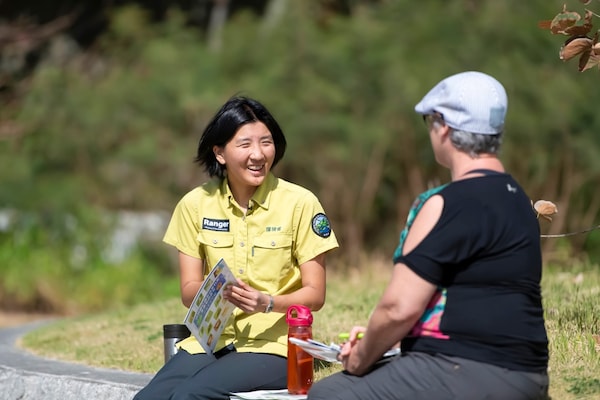
Yurika Ito is a ranger at the Ministry of the Environment, where she works to maintain the natural environment of the islands. Born in Tokyo, she has lived and worked on Hahajima for the past two years. From her, we learned of the unique environment and the endemic species on the island—and why protecting them through various conservation systems like the composting toilet are necessary.
”The islands of Ogasawara were formed by volcanic activity and have never been connected to the continent,” says Ito. This means that most of the life on the islands was carried here by birds, wind, and driftwood, and evolved independently from there. Hahajima is at a higher elevation than Chichijima, and is also characterized by humid, tall, wet forests.
She explained how non-native species threaten native species. She used an example from neighboring Chichijima, where an invasive species of planaria flatworms was introduced to the island over the past 30 years. Predatory in nature, it has driven the native land snails to the brink of extinction. “The planaria have not yet invaded Hahajima so there are still many endemic land snails,” says Ito. “But there are concerns about the impact of other invasive species that prey on land snails.” Another endangered species is the Ogasawara greenfinch. The bird is native only to the Hahajima archipelago and the Minami-Iwo Island, but its population is rapidly declining because its eggs are eaten by rats on the uninhabited islands where it breeds and the birds are attacked by cats on Hahajima. “In order to protect the birds, we are working to exterminate rats on the uninhabited islands and capture wild cats on Hahajima, after which we transport them to the mainland,”says Ito.
Government agencies and island organizations are cooperating to implement various measures to preserve certain species. One is the scrubbing of shoes with seawater and vinegar, something we did before disembarking on the island and prior to entering the island trails. This prevents foreign plants and animals from gaining a foothold on the island. In addition, the particularly important area of Sekimon is managed so that tourists entering the island’s natural environment for sightseeing must be accompanied by a certified guide. Ito recommends that visitors to Hahajima book a guide so that they can best enjoy the rich, subtropical rain forests.
Ito is pleased to see the installation of bio toilet, which she says is ideal for helping reduce damage and overusage of the nature reserve’s water resources.

Receive an explanation of Hahajima's endemic species and its unique environment
A bright future for Hahajima’s fragile environment
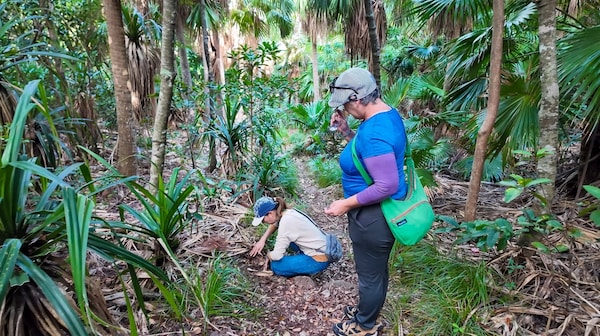
Looking for endemic land snails with Hahajima nature guide Itsuha Miyagawa
On our trip we met many enthusiastic local nature guides, conservation officers, and tourism officials who are working passionately on Hahajima to protect and preserve the islands unique flora, fauna and wildlife. Our final adventure was led by expert nature guide and forest ranger Itsuha Miyagawa, who led us through forest paths to see tropical birds and trees, lookout points she had helped clear, as well as some of the tiny snails and insects endemic to the island. We would never have been able to find these natural treasures on our own. Miyagawa added her positive thoughts about the new composting toilet to those of the other people we interviewed on our visit. “Both tourists and residents really appreciate these facilities,” she said. “Visitors are impressed by how clean, odorless, and easy to use they are.”
Our time on Hahajima was far too short, but still inspiring. We saw and heard of many examples of how other destinations across Japan—and even around the world—might implement strategies of composting toilet technology, conservation, and proactive community engagement to create visitor appeal that is in balance with the needs of the local people and the environment.

North Port composting toilet
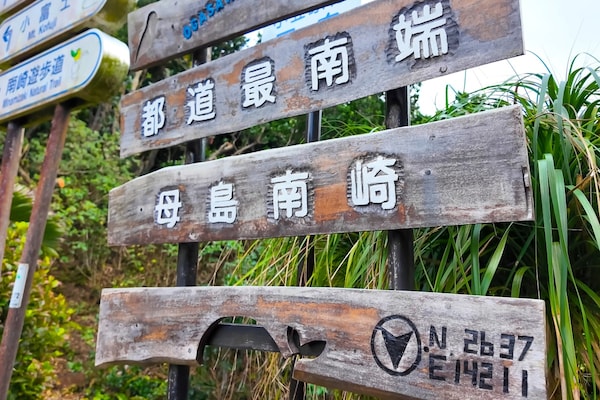
Southernmost point of the metropolitan road, Hahajima Minamisaki Rotary
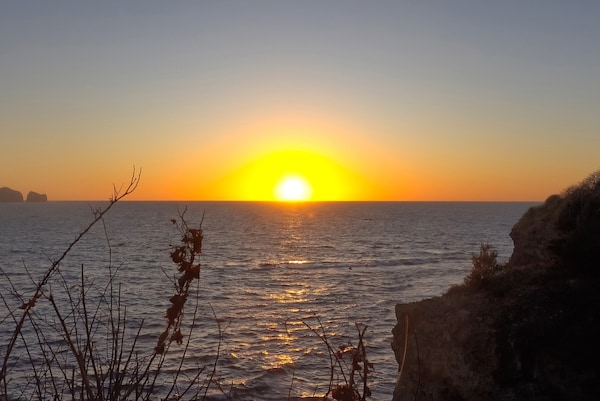
Very beautiful sunset at the observatory

Many whales can be seen.

[Reporter] Joy Jarman-Walsh
Joy first came to Japan from Hawaii, and in Hiroshima since 1996 where she co-founded the regional website GetHiroshima, taught business, communication, and tourism studies at university and launched her sustainability-focused business InboundAmbassador in 2019. The Seek-Sustainable-Japan show Joy creates has over 470 interviews with experts, authors, craftspeople and insiders from across Japan.
This content is supported by a grant from the Tokyo Convention & Visitors Bureau for the Promotion of Environmentally Friendly Travel.



